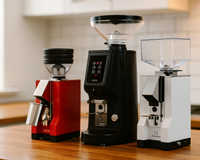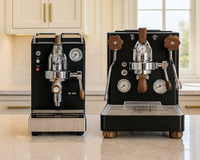Introduction
For anyone passionate about crafting the perfect espresso, the technique and tools you use are just as crucial as the quality of the coffee beans. Among these, the Weiss Distribution Technique (WDT) has emerged as a game-changer in the world of espresso preparation. This guide delves deep into the world of WDT tools, exploring their importance, benefits, and how to choose and use them effectively. Whether you're a home barista or a professional, understanding and implementing WDT can elevate your espresso shots to a new level.
What Are WDT Tools?
Understanding the Weiss Distribution Technique
The Weiss Distribution Technique (WDT) refers to a method of preparing coffee grounds in an espresso basket using a specific tool designed to break up clumps and evenly distribute the coffee before tamping. The technique was named after its inventor and has been widely adopted for its ability to improve consistency and quality in espresso extraction.
WDT tools typically consist of several thin needles attached to a handle. These needles are used to gently stir the coffee grounds in the portafilter, ensuring even distribution and minimizing the risk of channeling during extraction. By eliminating clumps and ensuring a uniform distribution, the WDT significantly enhances the espresso's flavor and consistency.
Components of a WDT Tool
A typical WDT tool includes:
- Needles: Usually made from metal, these are fine enough to gently agitate the grounds without compacting them.
- Handle: Designed to be easy to hold and manipulate, the handle may be made from various materials including wood, metal, or plastic.
- Base: Some WDT tools come with a base or stand for easy storage and to prevent damage to the needles.

Why Use a WDT Tool?
Benefits of Using WDT Tools in Espresso Preparation
The benefits of using a WDT tool include:
- Reduced Channeling: By evenly distributing the grounds, the water can flow through the coffee evenly, reducing the risk of channeling where water bypasses some of the coffee.
- Consistent Espresso Shots: Uniform distribution leads to consistent extraction, which is crucial for achieving the same taste and quality in every shot.
- Enhanced Flavor Profile: Even extraction pulls flavors evenly from all the coffee grounds, enhancing the overall flavor profile of the espresso.
RELATED: Troubleshooting a watery espresso puck
Common Espresso Making Problems Solved by WDT
WDT tools address several common problems in espresso making, including:
- Channeling: Where water finds the path of least resistance, often due to uneven distribution of grounds.
- Uneven Extraction: Results from clumps or gaps in the coffee bed, leading to bitter or sour shots.
How to Choose the Right WDT Tool
Factors to Consider When Buying a WDT Tool
When shopping for a WDT tool, consider the following factors:
- Needle Thickness: Thicker needles might disturb the coffee bed too much, while too thin might not be effective enough.
- Handle Comfort: Ensure the handle is comfortable to hold, as this can affect how effectively you can use the tool.
- Material and Build Quality: Durable materials like stainless steel or aluminum are preferred for longevity.
- Price: WDT tools can range from very affordable DIY options to more expensive, professionally crafted tools.
LUCCA WDT Tool from Cliff & Pebble >
Reviews and Recommendations
Before purchasing, check out reviews and recommendations. Look for feedback from other users, particularly regarding the tool's durability and effectiveness.
How to Use a WDT Tool
Step-by-Step Guide to Using a WDT Tool
To use a WDT tool effectively:
- Dose Your Coffee: Start by dosing the ground coffee into your portafilter.
- Insert the WDT Tool: Gently insert the needles into the coffee grounds.
- Stir Gently: Use the tool to stir the grounds, breaking up any clumps and ensuring the grounds are evenly distributed.
- Remove and Tamp: Carefully remove the WDT tool and proceed to tamp the grounds evenly.
Tips and Tricks for Perfect Espresso
- Be Gentle: The key is to agitate the grounds just enough to distribute them evenly without compacting them.
- Use a Consistent Technique: Try to replicate the same motion each time you use the WDT tool for consistent results.
- Clean Your Tool: Always keep your WDT tool clean to prevent old coffee grounds from affecting your espresso's taste.
Conclusion
The Weiss Distribution Technique and its associated tools offer a simple yet effective way to enhance your espresso-making skills. By incorporating a WDT tool into your espresso routine, you can achieve a more consistent, flavorful shot, reducing common issues such as channeling and uneven extraction. Whether you're an experienced barista or just starting out, mastering the use of a WDT tool can make a significant difference in your espresso quality.
Remember to visit our store and explore our selection of WDT tools. For more insights and tips on enhancing your coffee experience, don't forget to subscribe to our newsletter and stay updated with the latest trends and techniques in coffee making. Perfecting your espresso shots is just a WDT tool away!















